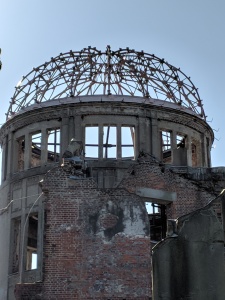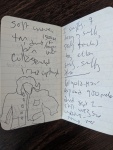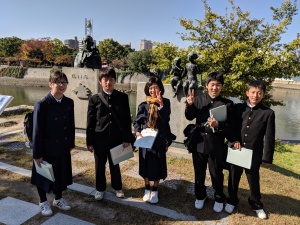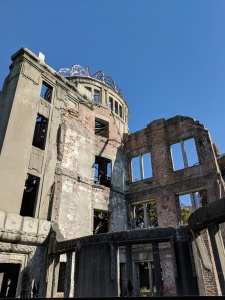This week, a Los Alamos museum blocked a traveling exhibit from the Hiroshima Peace Memorial Museum and Nagasaki Atomic Bomb Museum. The U.S. museum rejected the Japanese exhibit because it advocated abolishing nuclear weapons. (U.S. museum stalls Hiroshima exhibit.)
Last fall, I visited Hiroshima, and looked through the somber windows of history. I stood by the bombed remains of the Atomic Dome, a brick building located almost directly at ground zero, that somehow remained standing when every person in that domed building died instantly, and every nearby structure was destroyed.

I stared at the gaping windows and airy dome. Birds flitted about, landing easily atop the exposed roof. How could this skeletal structure, built in 1915, have withstood a nuclear bomb?
The two atomic bombs our country dropped on Japan ended World War II and saved the lives of countless American troops. It’s impossible to know the precise death toll, but updated reports estimate that 190,000 people died at Hiroshima, including 80,000 people who died immediately. Another 70,000 people died in Nagasaki.
After Nagasaki, the U.S. has never used nuclear weapons. Now, though, our president and some of his advisors threaten to unleash pre-emptive nuclear war against North Korea. Loose words from people who don’t seem to understand the horror of atomic bombs.
The traveling exhibit that the Los Alamos museum rejected would have brought clothes, broken plates and other personal items from victims. Those mundane items help tell the story of what nuclear war means.
In the Hiroshima Peace Memorial Museum, I and other visitors stood silently, staring at scorched and frayed objects. A rusted tricycle a toddler had been riding when the bomb hit. Shinichi Tetsutani was three years, eleven months old on August 6, 1945. His father buried Shinichi with his tricycle in their backyard. Later, when the toddler was reburied in the family grave, his father donated the tricycle to the peace park.
The exhibits tell about a third grade boy who died, wearing this faded tan jacket with the upright collar. A girl who didn’t recognize her badly burned father and brother crawling past her on the street. It’s hard to look at ordinary items, reminders of the world’s most potent weapons. Seeing a tricycle, a schoolboy’s frayed jacket, makes history real.

I didn’t take photos inside the museum. Instead, I wiped away tears, took notes, drawing rough sketches, a simple attempt to remember history. I wanted to remember what I saw, what nuclear weapons can do. I heard the choked sobs and sniffling of other adults. I noticed school groups, some students looking uncomfortable, others, trying to tune out, looking at their phones.
I read how Japanese high school students lobbied to save the Atomic Dome building. Adults wanted to demolish the damaged Dome, to hide a scar from the painful past. Students prevailed. Since 1996, the Dome has been listed as a World Heritage site. It’s a place people from around the world can see history.

Japanese people know the history and power of atomic warfare. Does our president understand that history? Do enough Americans know what nuclear war means? I had the chance to look into the windows of history at Hiroshima, thinking about the past and worrying about the future.
If the Los Alamos museum won’t accept the Hiroshima and Nagasaki traveling exhibit, I hope another U.S. museum will rise to the occasion and welcome the traveling exhibit. You don’t need to travel to learn history, but all of us– school kids, ordinary citizens, and even presidents– do need to read, listen, and learn about the past. We need to look into the windows of history.


Must have been fascinating to be there, great post!
LikeLike
Thanks, Roselinde. I am grateful for the chance to travel. A college friend who is Japanese welcomed us into her home and showed us around her country.
LikeLiked by 1 person